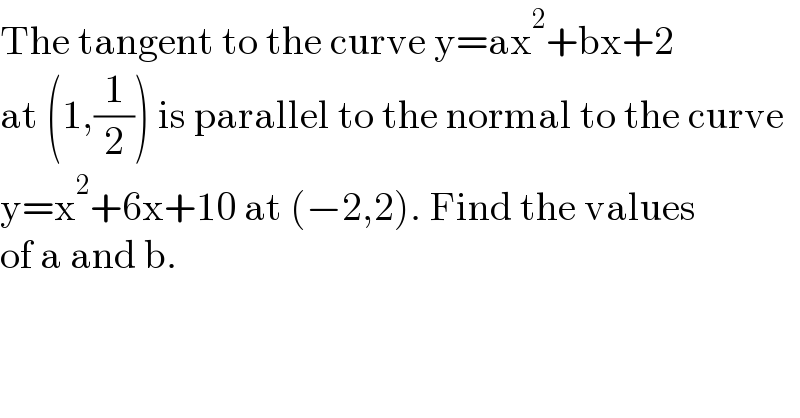
Question Number 171315 by pete last updated on 12/Jun/22

$$\mathrm{The}\:\mathrm{tangent}\:\mathrm{to}\:\mathrm{the}\:\mathrm{curve}\:\mathrm{y}=\mathrm{ax}^{\mathrm{2}} +\mathrm{bx}+\mathrm{2} \\ $$$$\mathrm{at}\:\left(\mathrm{1},\frac{\mathrm{1}}{\mathrm{2}}\right)\:\mathrm{is}\:\mathrm{parallel}\:\mathrm{to}\:\mathrm{the}\:\mathrm{normal}\:\mathrm{to}\:\mathrm{the}\:\mathrm{curve} \\ $$$$\mathrm{y}=\mathrm{x}^{\mathrm{2}} +\mathrm{6x}+\mathrm{10}\:\mathrm{at}\:\left(−\mathrm{2},\mathrm{2}\right).\:\mathrm{Find}\:\mathrm{the}\:\mathrm{values} \\ $$$$\mathrm{of}\:\mathrm{a}\:\mathrm{and}\:\mathrm{b}. \\ $$
Answered by som(math1967) last updated on 12/Jun/22
![Tangent to the curve y=ax^2 +bx+2 at (1,(1/2)) ∴(1/2)=a+b+2 ⇒a+b=−(3/2) .....i) ⇒ slope of tangent (dy/dx)=2ax+b [(dy/dx)]_(1,(1/2)) = 2a+b slope of normal y=x^2 +6x+10 −(dx/dy)=((−1)/(2×−2+6))=((−1)/2) ∴ 2a+b=−(1/2)......ii) from i) and ii) a=−(1/2)+(3/2)=1 b=−(3/2)−1=((−5)/2)](Q171316.png)
$${Tangent}\:{to}\:{the}\:{curve}\:{y}={ax}^{\mathrm{2}} +{bx}+\mathrm{2} \\ $$$$\:{at}\:\left(\mathrm{1},\frac{\mathrm{1}}{\mathrm{2}}\right)\:\therefore\frac{\mathrm{1}}{\mathrm{2}}={a}+{b}+\mathrm{2} \\ $$$$\left.\:\Rightarrow{a}+{b}=−\frac{\mathrm{3}}{\mathrm{2}}\:.....{i}\right) \\ $$$$\Rightarrow \\ $$$${slope}\:{of}\:{tangent} \\ $$$$\:\:\frac{{dy}}{{dx}}=\mathrm{2}{ax}+{b} \\ $$$$\left[\frac{{dy}}{{dx}}\right]_{\mathrm{1},\frac{\mathrm{1}}{\mathrm{2}}} =\:\mathrm{2}{a}+{b} \\ $$$${slope}\:{of}\:{normal} \\ $$$${y}={x}^{\mathrm{2}} +\mathrm{6}{x}+\mathrm{10} \\ $$$$\:−\frac{{dx}}{{dy}}=\frac{−\mathrm{1}}{\mathrm{2}×−\mathrm{2}+\mathrm{6}}=\frac{−\mathrm{1}}{\mathrm{2}} \\ $$$$\left.\:\therefore\:\mathrm{2}{a}+{b}=−\frac{\mathrm{1}}{\mathrm{2}}......{ii}\right) \\ $$$$\left.{f}\left.{rom}\:{i}\right)\:{and}\:{ii}\right) \\ $$$$\:{a}=−\frac{\mathrm{1}}{\mathrm{2}}+\frac{\mathrm{3}}{\mathrm{2}}=\mathrm{1} \\ $$$${b}=−\frac{\mathrm{3}}{\mathrm{2}}−\mathrm{1}=\frac{−\mathrm{5}}{\mathrm{2}} \\ $$
Commented by pete last updated on 12/Jun/22

$$\mathrm{thank}\:\mathrm{you}\:\mathrm{very}\:\mathrm{much}\:\mathrm{sir},\:\mathrm{i}\:\mathrm{am}\:\mathrm{grateful}. \\ $$
